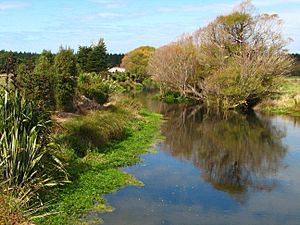Styx River (Canterbury) facts for kids
Quick facts for kids Styx River |
|
|---|---|

The Styx River near Spencerville
|
|
| Country | New Zealand |
| Physical characteristics | |
| Main source | Harewood |
| River mouth | Waimakariri River via Brooklands Lagoon |
| Length | 24.8 km (15.4 mi) |
| Basin features | |
| Basin size | 50 km2 (19 sq mi) |
The Styx River (Māori: Puharakekenui) is a special waterway in New Zealand. It flows along the northern edge of Christchurch and eventually joins the Waimakariri River through Brooklands Lagoon. The area around the river, called its catchment, even has its own website!
Where the Styx River Flows
The Styx River starts in Harewood, a suburb of Christchurch. Here, a dry ditch, called a swale, sometimes fills with stormwater (rainwater runoff). As the river flows northeast, many natural springs add water to it.
The Styx River has two main smaller rivers, called tributaries, that flow into it: the Kaputone Stream and Smacks Creek. Many other smaller waterways, both natural and man-made, also drain into the Styx River.
The river passes through several areas like Belfast, Marshland, and Spencerville. Finally, it reaches Brooklands, where it flows into the Brooklands Lagoon. From there, the water joins the Waimakariri River, which then flows out into Pegasus Bay.
How the Styx River Got Its Name
The Māori name for the Styx River is Puharakekenui.
The European name, Styx, has a few interesting stories about how it came to be. These stories show that early European settlers traveled through this wet, swampy area.
One idea is that settlers crossed the river using rafts made of flax sticks. So, they might have called it "Sticks," which later changed to "Styx." Another idea is that bundles of flax sticks were placed in the riverbed to help people cross. A third story suggests that flax sticks were stuck in the ground to guide travelers to where logs formed a bridge over the river.
However, the name Styx also comes from a famous mythical river in ancient Greek stories. This mythical Styx was believed to be the boundary between the Earth and the underworld. Some people think that crossing the Styx River in New Zealand might have felt difficult, like entering a different world, which reminded settlers of the mythical river. The name "Styx" first appeared in official records in 1865–66.
Styx Vision: A Plan for the Future
The area around the Styx River is growing quickly with new buildings and towns. Because of this, a 40-year plan was created in the late 1990s. This plan, called the "Styx Vision 2000–2040," looks at ways to protect and improve the river's environment. The Christchurch City Council officially adopted this plan on July 11, 2001.
The Styx Vision has five main goals:
- Vision 1: A Healthy River Ecosystem
* To make sure the river's natural environment, fed by springs, stays healthy. This helps protect it like other special places in Christchurch, such as the Port Hills and Travis Wetlands.
- Vision 2: A Journey from Source to Sea
* To create an "Urban National Reserve" along the river. This would allow people to experience the river's journey from where it starts to where it meets the sea.
- Vision 3: A Living Laboratory
* To turn the area into a place for learning and research. This is inspired by botanist Leonard Cockayne (1885–1934), who studied plants.
- Vision 4: A Special Place
* To keep and improve the unique feeling and identity of the Styx River area.
- Vision 5: Working Together
* To encourage strong partnerships and good relationships among everyone involved in protecting the river.
These goals help guide future actions and projects. The Christchurch City Council has already bought large areas of land next to the waterways in the Styx area. This land will eventually form a connected network of natural spaces, helping the river's ecosystem thrive.

